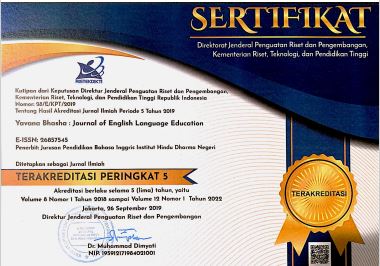an An Analysis Of Speech Act And Politeness Strategy Used By English Lecturer of Dwijendra University in Online Classroom Interaction
DOI:
https://doi.org/10.25078/yb.v5i2.1039Keywords:
Online Learning, Politeness Strategy, Speech ActAbstract
Speech act and politeness strategy are widely known as a part of pragmatics in which certain aims are conveyed beyond the words or phrases when a speaker says something. Both apply as acts that refer to the action performed by the utterances produced during an intercourse. The aims of this study was finding out what types of politeness strategy and speech acts used by English lecturer during online class’s instruction. The subject of this research is an English lecturer at Dwijendra University. The data were collected through two steps; an observation on politeness strategy and speech act used during the online learning and then an interview to verify the observed data. It is a qualitative descriptive study which was conducted in two steps; first step is to observe how English lecturer apply politeness strategies and speech act in online learning. Second, interview is conducted with research subjects to verify the observed data. In addition, there are two theories applied in this research namely Brown & Levinson's theory of politeness strategies and Searle's theory of speech act. The result of the study found out that English Lecturer use four types of politeness strategies during an online learning; bald-on record, positive politeness, negative politeness, and off-record. Besides, five types of speech acts were found to be used by the English lecturer during his online learning; representative, directive, commissive, expressive, and directive. This study also discovered that an English lecturer used more directive speech acts during online learning.
Keyword: Online Learning, Politeness Strategy, Speech Act








